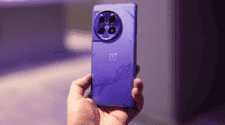HMD Global, the Finnish company behind Nokia-branded smartphones, has been working on reviving the iconic Nokia Lumia series. The latest development suggests that the upcoming model will be a Nokia-branded smartphone. This is in contrast to previous reports that claim that HMD smartphones will no longer use the Nokia brand. This phone will be a replica of the classic Lumia design and will feature the iconic Nokia logo printed on it.

Key Features of the Nokia Lumia Replica
The Nokia Lumia replica phone with the codename SkyLine should be a mid-range contender with high-end features. It will come with a Qualcomm Snapdragon 7s Gen 2 chip, 12GB RAM, and 256GB storage space. The phone will also feature a triple-lens setup on the back, consisting of a 108MP main sensor, an 8MP ultrawide sensor, and a 2MP macro or depth sensor. The front camera will be a 32MP unit. The phone will have a large-capacity 4900mAh battery with support for 33W wired charging.
Display and Performance
According to rumours, the display of this device will be a major highlight. It will feature an FHD+ OLED touchscreen with a smooth 120Hz refresh rate. This will provide a seamless and immersive experience for users. The phone will also support Bluetooth 5.2 and NFC and will have dual speakers with OZO audio technology and PureView technology.

Design and Appearance
The design of the SkyLine will return to the classic “Fabula” design of the Lumia era. This should bring a nostalgic treat for fans of the series. The phone will be available in four colours: pink, blue, green, and yellow.
Operating System and Price
The SkyLine will run on the latest Android 14 operating system out of the box. It provides users with a familiar yet novel experience. The price of the phone should be between 522 and 539 euros.

History of the Nokia Lumia Series
The Nokia Lumia series is a line of mobile devices that was originally designed and marketed by Nokia and later by Microsoft. The series was introduced in 2011 and was known for its innovative design, user-friendly interface, and high-quality cameras. Here is an exhaustive history of the Nokia Lumia series:
Early Years (2011-2013)
The Nokia Lumia series was launched in 2011 with the Nokia Lumia 800, which was a Windows Phone 7 smartphone based on the Nokia N9 design. The phone was well-received for its sleek design and user-friendly interface. The Lumia 800 was followed by the Lumia 900, which was released in 2012 and featured a larger screen and improved camera.
Gizchina News of the week
In 2012, Nokia announced the Lumia 920, which was a flagship device with a 4.5-inch screen, 4G LTE, and an 8.7-megapixel camera with Nokia’s PureView technology. The reviews for this device were very positive for its camera capabilities.
Microsoft Acquisition (2013-2014)
In September 2013, Microsoft announced its intent to acquire Nokia’s mobile phone business, including the rights to the Lumia and low-end Asha brands, for over $7 billion. In early 2014, news of the deal officially hit the public with Microsoft Mobile becoming the successor to Nokia’s mobile devices division
The acquisition was a significant move for Microsoft, as it aimed to accelerate the growth of its share and profit in mobile devices. Microsoft would license the Nokia name for feature phones running Series 30, Series 30+, and Series 40 mobile operating systems, but not for smartphones. This meant that future Lumia models would be first-party hardware from Microsoft.
Microsoft Lumia Devices (2014-2015)
After the acquisition, Microsoft released several Lumia devices, including the Lumia 535, Lumia 435, and Lumia 730. These devices ran on Windows Phone 8.1 and featured improved cameras and design. These devices marked a significant shift in Microsoft’s strategy, as they aimed to provide a range of options for different budgets and needs. The Lumia 535 and Lumia 430/435 targeted budget-conscious consumers, while the Lumia 550 and Lumia 650 catered to those looking for more advanced features. The Lumia 950 series, on the other hand, was designed to compete with high-end Android and iOS devices.
Discontinuation and Legacy (2015-2016)
In July 2014, Microsoft announced that it would discontinue the majority of its Nokia-branded devices, including the Asha, S30, S40, and X platforms. The company focused on low-cost Lumia devices and discontinued the Nokia brand for smartphones.
The Nokia brand did not stop releasing feature phones. However, in May 2016, Microsoft sold the rights to the Nokia brand for feature phones to HMD Global. HMD Global released the first Nokia-branded Android phone, the Nokia 6, in January 2017.
Legacy and Impact
The Nokia Lumia series played a significant role in the development of Windows Phone and the smartphone market as a whole. At the time, the market knows the series for its innovative design, high-quality cameras, and user-friendly interface. Although the series didn’t continue, its legacy continues to influence the smartphone industry.
Timeline
– 2011: Nokia Lumia 800 launched
– 2012: Nokia Lumia 900 and Lumia 920 released
– 2013: Microsoft acquires Nokia’s mobile phone business
– 2014: Microsoft releases Lumia 535, Lumia 435, and Lumia 730
– 2014: Microsoft discontinues majority of Nokia-branded devices
– 2016: Microsoft sells Nokia brand for feature phones to HMD Global
– 2017: HMD Global releases first Nokia-branded Android phone, the Nokia 6
Conclusion
The Nokia Lumia replica phone with the codename SkyLine should be a decent addition to the Nokia brand. With its high-end features, classic design, and nostalgic appeal, it is likely to be a popular choice among fans of the series. The inclusion of the iconic Nokia logo printed on the phone will be a welcome touch for those who have fond memories of the Lumia series. What do you think about the potential return of the Lumia brand? Let us know your thoughts in the comment section below






With a punch hole for your viewing pleasure (unlike the original)